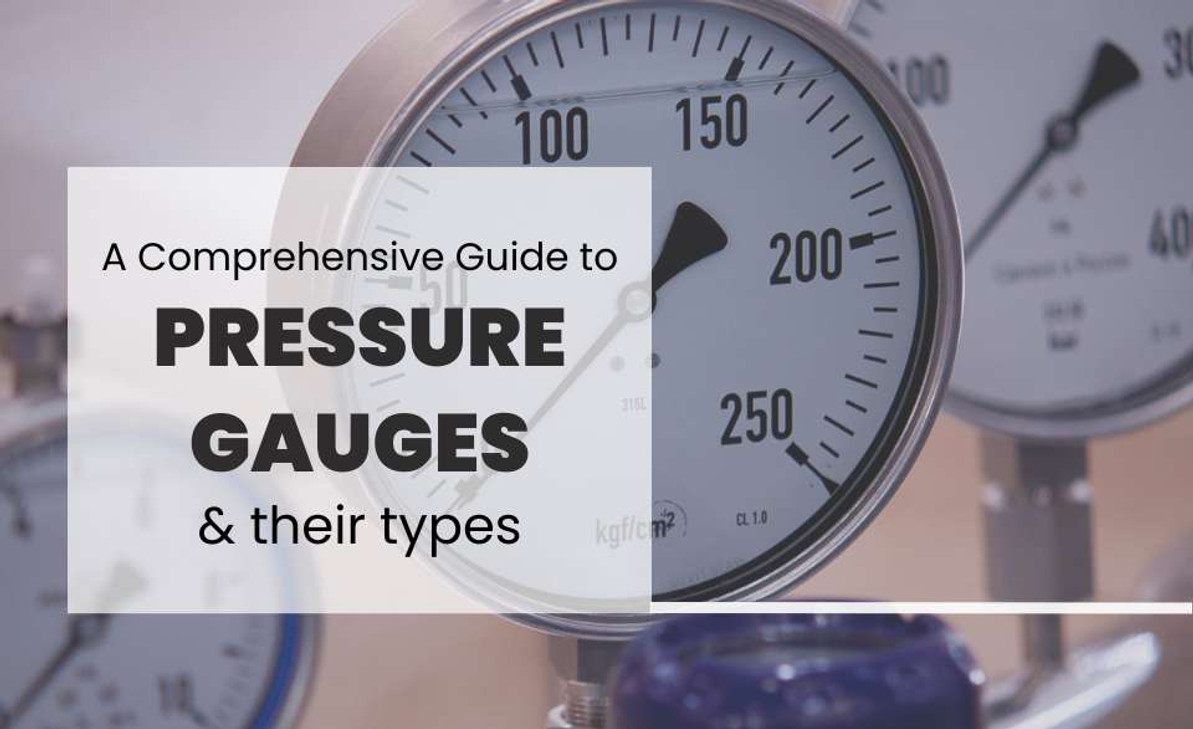A Comprehensive Guide to Pressure Gauges and their types
Pressure gauges are one of the most fundamental and widely used instruments for measuring the pressure of liquids and gases. From industrial processes to aerospace and aviation, pressure gauges play a critical role in ensuring the safe and efficient operation of countless systems and processes. By providing a visual indication of pressure, pressure gauges allow operators to monitor and control pressure levels, which is essential for maintaining the integrity of the system and preventing accidents. In this age of automation and advanced technology, pressure gauges remain a simple yet essential tool for keeping things running smoothly. In this context, let's dive deeper into the world of pressure gauges, from their history and types to their applications, accuracy, and safety tips.
What is a pressure gauge?
A pressure gauge is a measuring instrument that is used to determine the pressure of a gas or liquid within a system. It typically consists of a dial or a digital display that indicates the pressure in pounds per square inch (psi), bar, or another unit of measurement.
Pressure gauges can be used in a variety of applications, including in hydraulic and pneumatic systems, industrial processes, and HVAC systems. They are designed to withstand the pressure and temperature conditions of their intended application and come in a range of sizes and styles to accommodate different mounting and connection requirements.
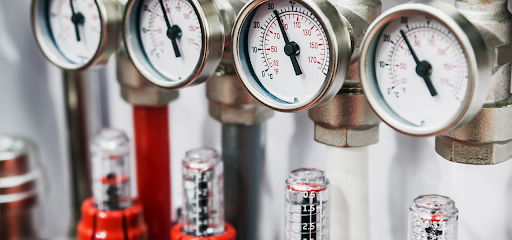
Fig 1. Pressure gauges
Some pressure gauges are designed to measure both pressure and temperature simultaneously, while others may be equipped with additional features such as alarms or digital output signals for remote monitoring and control. Proper calibration and maintenance are important to ensure accurate and reliable measurements over time.
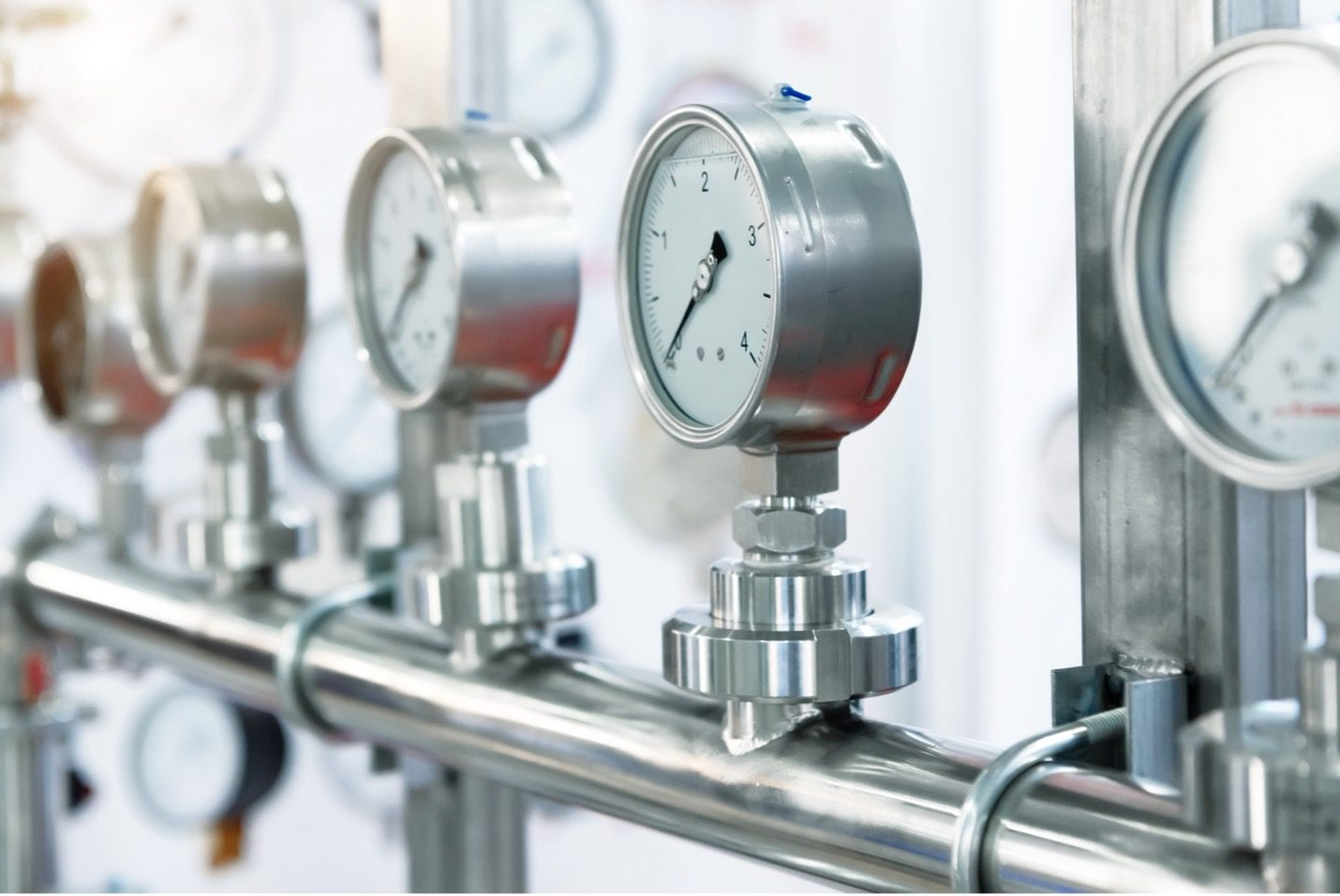
Fig 2. Pressure gauges in the industry
Pressure gauges are essential tools for many industrial applications, but for a wider range and more advanced features, Check Pressure Transmitter Products.
Pressure Gauge History
The first pressure gauge was invented in the 17th century by the French physicist and mathematician Blaise Pascal. Pascal discovered that fluids transmit pressure equally in all directions, and he used this principle to develop a device that could measure the pressure of liquids and gases.
The earliest pressure gauges were based on a simple U-shaped tube, which was partially filled with liquid and connected to the system being measured. As pressure increased, the liquid level in one arm of the tube would rise, while the level in the other arm would fall, providing a visual indication of the pressure difference.
In the 19th century, Bourdon tubes were introduced, which offered a more practical and accurate way to measure pressure. A Bourdon tube is a curved metal tube that straightens as presBourdon tube, diaphragm, capsule, or bellowssure is applied, which can be used to operate a pointer on a dial or indicator.
Today, pressure gauges come in a wide range of styles and designs, including digital and analog displays, and they are used in a variety of industries and applications, from automotive and aerospace to manufacturing and healthcare.
Pressure Gauge Structure
The basic structure of a pressure gauge consists of a sensing element, a mechanism for transmitting the sensed pressure to a display, and a display for indicating the measured pressure.
The sensing element is part of the pressure gauge that is in contact with the fluid or gas being measured. It is designed to convert the applied pressure into a mechanical deflection, which can then be transmitted to the display mechanism. The sensing element can take many forms, such as a Bourdon tube, diaphragm, capsule, or bellows, depending on the application.
The display mechanism is responsible for converting the mechanical deflection of the sensing element into a readable value. In analog pressure gauges, this is typically done using a pointer and a dial, while digital pressure gauges use electronic displays. The display mechanism may also include additional features, such as alarms, switches, or output signals.
The pressure transmission mechanism is used to connect the sensing element to the display mechanism. It typically consists of a linkage or connecting rod that translates the motion of the sensing element into a corresponding motion of the display mechanism. The pressure transmission mechanism is critical for ensuring accurate readings and must be designed to minimize hysteresis, friction, and other sources of error.
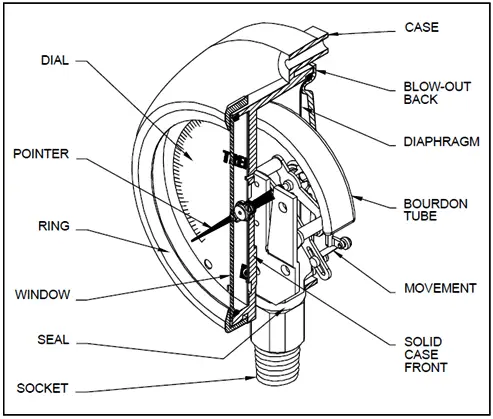
Fig 3.The main parts of a pressure gauge
ELEMENTS OF MEASURING PRINCIPLE
The Bourdon Tube Pressure Gauge
A Bourdon tube pressure gauge is a mechanical instrument used to measure and display the pressure of a fluid or gas in a system. It operates on the principle of elastic deformation of a curved tube known as a Bourdon tube. Here's how it works:
C-shaped
The heart of the gauge is a hollow, curved tube typically made of metal (usually bronze or stainless steel) with an oval or coiled cross-section. One end of the tube is fixed, while the other end is connected to the system whose pressure is being measured.
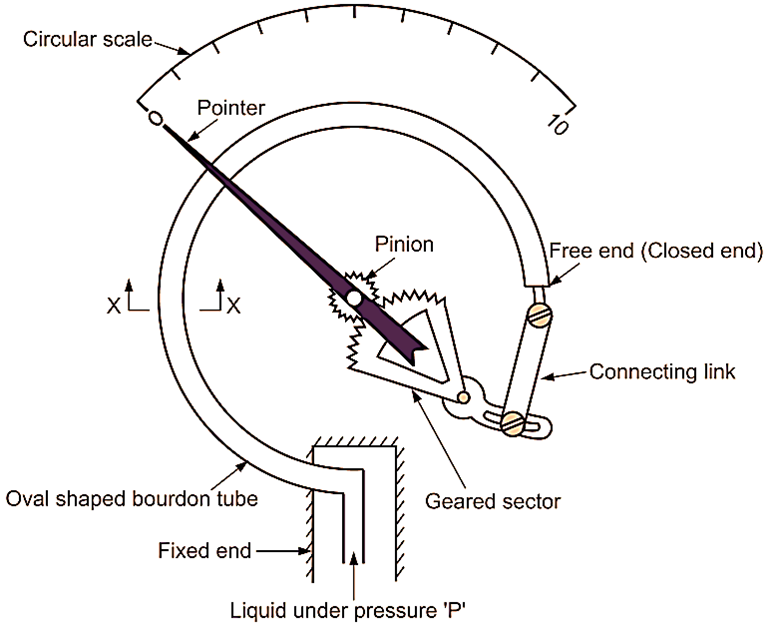
Fig 4. The bourdon tube pressure gauge
Pressure Application
When the system pressure increases, the fluid or gas enters the Bourdon tube through the connection at the fixed end. The pressure inside the tube causes it to deform.
Tube Deformation
As the pressure inside the Bourdon tube increases, it attempts to straighten itself due to the elastic properties of the metal. The tube undergoes an arc-like movement, changing from its original curved shape.
Linkage and Indicator
The curved end of the Bourdon tube is linked to a mechanical linkage system that amplifies the tube's movement. This linkage is typically connected to a pointer or a dial mechanism that displays the pressure reading.
Pressure Display
As the Bourdon tube deforms, the movement is transmitted through the linkage system, resulting in the rotation of the pointer or movement of the dial. The position of the pointer or the value displayed on the dial indicates the corresponding pressure being measured.
Helical Bourdon Tube
The technology used in helical tube pressure gauges is similar to that used in the C-shaped Bourdon tube gauges, with some variations due to the differences in the tube configuration. Here's an overview of the technology used in helical tube pressure gauges:
Helical Bourdon Tube
The helical tube is the sensing element of the gauge. It is typically made from thin-walled tubing with a circular cross-section, formed into a helical or spiral shape. One end of the tube is sealed, and the other end is connected to the pressure source.

Fig 5. Helical tube
Linkage System
The free end of the helical Bourdon tube is linked to a mechanical linkage system. The linkage system consists of levers, gears, and pinions that amplify the small movement of the tube and transmit it to the indicator or pointer.
Pointer or Dial
The linkage system connects the helical tube to a pointer or dial that indicates the pressure measurement. The pointer is typically attached to a shaft, which rotates as the tube deforms, providing a visual display of the pressure reading.
Construction Materials
The materials used in helical tube pressure gauges are similar to those used in C-shaped Bourdon tube gauges, such as brass, bronze, stainless steel, and other metals. The materials are chosen based on the specific requirements of the application, including the pressure range, temperature, and corrosion resistance.
Accuracy
Helical tube pressure gauges are known for their accuracy and linearity. The coiled shape of the tube provides increased sensitivity and responsiveness to pressure changes, enabling accurate measurement of pressure values over a wide range.
Spiral Bourdon Tube
The spiral Bourdon tube is characterized by a continuous spiral coil that forms the sensing element of the pressure gauge. The tube is typically made of a resilient material such as metal, usually bronze or stainless steel, which possesses elastic properties.
When pressure is applied to the spiral Bourdon tube, it undergoes elastic deformation due to its curved shape and material properties. The coil-shaped tube tends to straighten or unwind in response to the pressure change, resulting in a rotational motion along its axis.
This rotational motion is then converted into linear displacement using a mechanical linkage system similar to that used in other Bourdon tube pressure gauges. The movement is transmitted to an indicator or pointer, which displays the pressure reading on a dial or scale.
The spiral Bourdon tube design offers advantages such as increased sensitivity, improved stress distribution, and compactness. It can accommodate higher pressure ranges while maintaining accuracy and linearity. However, it's worth noting that spiral Bourdon tubes are less common compared to the traditional C-shaped or helical Bourdon tubes.

Fig 6. Spiral tube
The Capsule
The element consists of two thin corrugated sections sealed about their circumference. The capsule thus formed acts as a cavity and slightly deforms when pressure is applied. Through a link and geared movement, this deflection is converted into the rotation of a concentric pointer to be indicated on a dial scale. Capsule pressure gauges are intended for the measurement of low negative and positive pressure. Several capsules may be combined to enable measurement of very low pressure. Measuring ranges from 0 to 600 bar.

Fig 7. Capsule principle
The Bellows
The element consists of a thin-walled tube of a harmonica-like shape. The pressure is normally applied to the inside of the bellows. The bellows will expand in length when pressure is applied. Through a link and geared movement, this deflection is converted into the rotation of a concentric pointer to be indicated on a dial scale. Bellows pressure gauges are intended for measurement of very low pressure. They are mainly used in differential pressure gauges.

Fig 8. Bellows principle
The Diaphragm
The element consists of a thin convoluted membrane that is held between two flange halves, where the bottom half incorporates the pressure entry. The diaphragm deflects when pressure is applied. Through a geared movement, this deflection is converted into the rotation of a concentric pointer to be indicated on a dial scale. The value indicated is proportional to the pressure applied.

Fig 9. Diaphragm principle
How does a Pressure Gauge work?
A pressure gauge works by measuring the force exerted by a gas or liquid on a sensing element and converting that force into a readable value.
The sensing element of a pressure gauge is typically a flexible structure, such as a Bourdon tube, diaphragm, or bellows, which deforms in response to the applied pressure. As the pressure changes, the sensing element expands or contracts, causing a corresponding motion of the display mechanism.
The motion of the sensing element is transmitted to the display mechanism through a linkage or connecting rod. In analog gauges, the linkage typically moves a pointer across a dial, while digital gauges use electronic sensors to convert the mechanical motion of the sensing element into a digital signal.
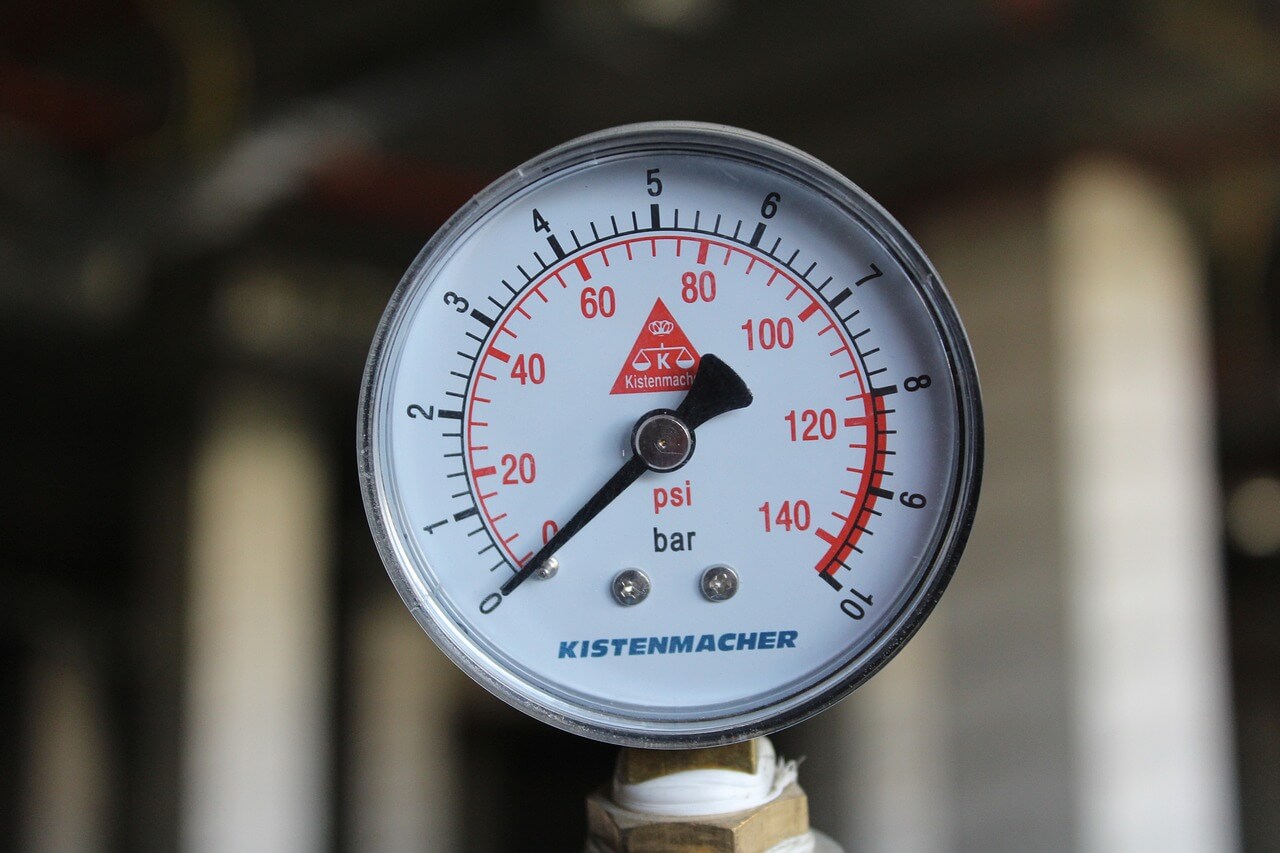
Fig 10. Operation of the pressure gauge
The display mechanism of a pressure gauge is designed to provide a clear and accurate reading of the measured pressure. Analog gauges typically use a pointer and a dial, with the pointer indicating the pressure value on a calibrated scale. Digital gauges use electronic displays, which can provide more precise and flexible readouts, such as multiple units of measurement, data logging, and alarm functions.
To ensure accurate and reliable readings, pressure gauges must be calibrated and maintained regularly, and they must be used within their specified pressure range and environmental conditions. Incorrect use or calibration can lead to errors, drift, or even failure, which can cause safety hazards, equipment damage, or production losses.
Pressure Gauge Types
There are many different types of pressure gauges, each with its design and function. The choice of a particular type of pressure gauge depends on the application requirements, such as the pressure range, accuracy, temperature, and environment. Some of the most common types of pressure gauges are:
1. Bourdon tube gauge: The Bourdon tube gauge is one of the most widely used pressure gauges. It consists of a curved metal tube that straightens when pressurized, which moves a pointer on a calibrated dial. Bourdon tube gauges are reliable and accurate and can measure pressures ranging from vacuum to high pressure.
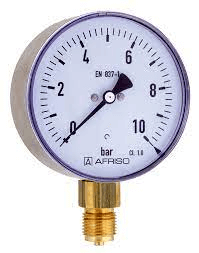
Fig 11. Bourdon tube gauge
2. Diaphragm gauge: Diaphragm gauges use a flexible diaphragm to measure pressure. When pressure is applied, the diaphragm deforms, which moves a pointer or a digital display. Diaphragm gauges are suitable for low-pressure applications and can measure both positive and negative pressures.
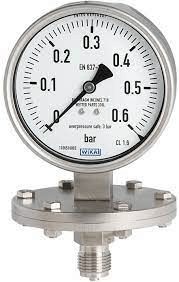
Fig 12. diaphragm pressure gauge
3. Capsule gauge: Capsule gauges consist of two thin-walled diaphragms that are welded together at the edges to form a sealed capsule. When pressure is applied, the capsule expands or contracts, which moves a pointer or a digital display. Capsule gauges are suitable for low-pressure applications and can measure both positive and negative pressures.
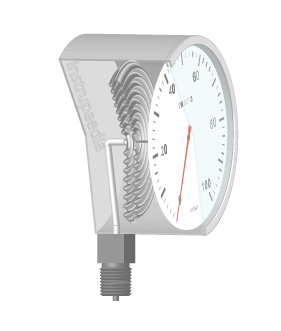
Fig 13. Capsule gauge
4. Bellows gauge: Bellows gauges use a convoluted metal tube to measure pressure. When pressure is applied, the bellows expand or contract, which moves a pointer or a digital display. Bellows gauges are suitable for low-pressure applications and can measure both positive and negative pressures.
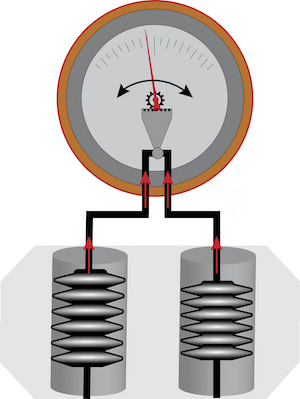
Fig 14. Bellows gauge
5. Differential pressure gauge: Differential pressure gauges are used to measure the difference in pressure between two points in a system. They consist of two pressure-sensing elements, such as Bourdon tubes or diaphragms, that are connected to a differential pressure gauge mechanism. Differential pressure gauges are widely used in HVAC, filtration, and flow measurement applications.
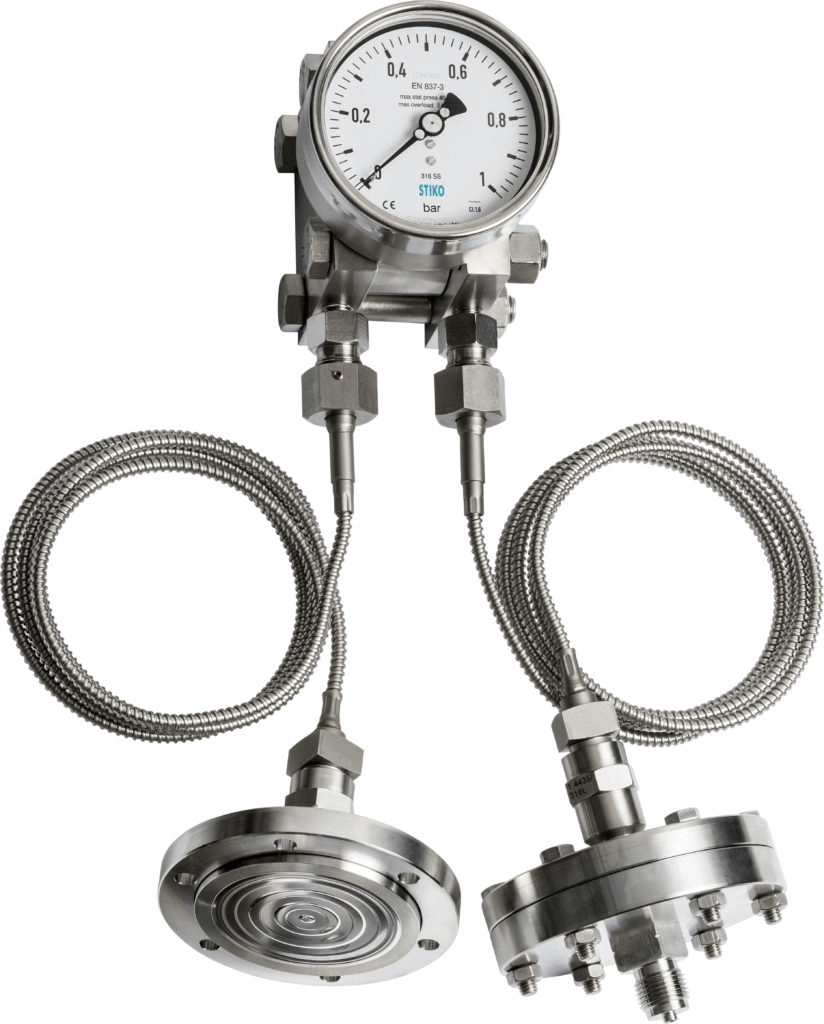
Fig 15. Differential pressure gauge
6. Digital pressure gauge: Digital pressure gauges use electronic sensors to measure pressure and display the results on a digital display. They offer high accuracy, resolution, and flexibility, and can provide additional features such as data logging, alarms, and remote monitoring. Digital pressure gauges are suitable for a wide range of applications and can measure both positive and negative pressures.
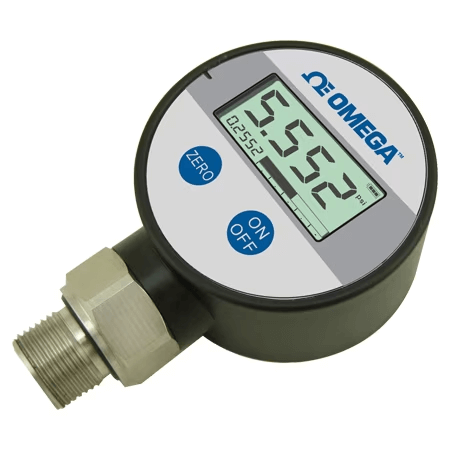
Fig 16. Digital pressure gauge
7. Vacuum gauge: Vacuum gauges are used to measure pressures below atmospheric pressure. They can be based on any of the above types of pressure gauges, but they are typically calibrated to read in units such as torr, millibar, or inches of mercury.
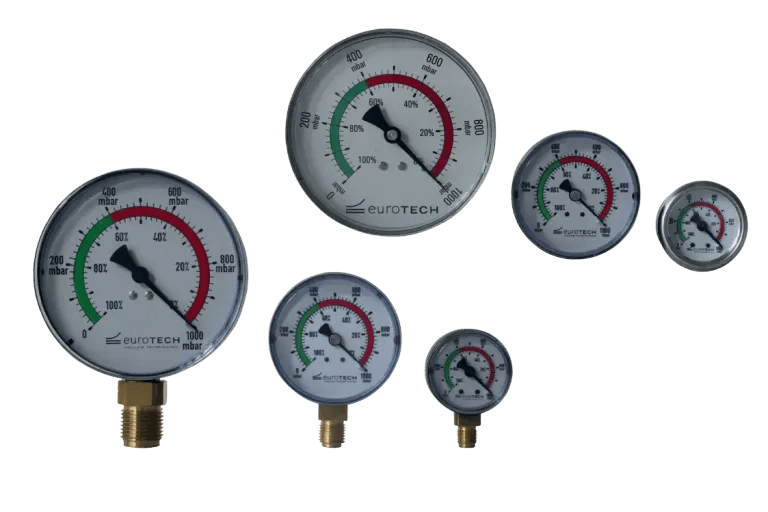
Fig 17. Vacuum gauge
In addition to these basic types, there are many specialized pressure gauges, such as high-pressure gauges, sanitary gauges, submersible gauges, and explosion-proof gauges, which are designed to meet specific application requirements.
The Usage of Each Type
here's a breakdown of each type of pressure gauge and its typical usage:
1. Bourdon tube gauge
Bourdon tube gauges are widely used in industrial and commercial applications to measure pressure in liquids, gases, and vapors. They can measure both positive and negative pressures and are suitable for a wide range of pressure ranges, from vacuum to high pressure. They are commonly used in applications such as pipelines, compressors, hydraulic systems, and boilers.
2. Diaphragm gauge
Diaphragm gauges are suitable for low-pressure applications, typically up to a few hundred psi. They are commonly used to measure gas pressure in HVAC systems, laboratory equipment, and pneumatic devices.
3. Capsule gauge
Capsule gauges are also suitable for low-pressure applications, typically up to a few hundred psi. They are commonly used in applications such as gas distribution systems, pneumatic controls, and medical devices.
4. Bellows gauge
Bellows gauges are also suitable for low-pressure applications, typically up to a few hundred psi. They are commonly used in applications such as vacuum systems, low-pressure gas distribution, and precision instruments.
5. Differential pressure gauge
Differential pressure gauges are used to measure the difference in pressure between two points in a system, such as across a filter or flowmeter. They are commonly used in HVAC systems, chemical processing, and fluid flow measurement.
6. Digital pressure gauge
Digital pressure gauges are suitable for a wide range of applications, from low to high pressure, and can measure both positive and negative pressures. They offer high accuracy, resolution, and flexibility, and are commonly used in laboratory, process control, and testing applications.
7. Vacuum gauge
Vacuum gauges are used to measure pressures below atmospheric pressure. They are commonly used in applications such as vacuum furnaces, vacuum pumps, and vacuum packaging.
In addition to these general applications, each type of pressure gauge may have specific design features, such as materials, connections, or certifications, that make them suitable for particular industries or environments. For example, sanitary gauges may have special fittings and materials to meet hygiene requirements in food and pharmaceutical applications, while explosion-proof gauges may have special enclosures to prevent ignition in hazardous environments.
Pressure Gauge Applications
Pressure gauges are used in a wide range of industrial, commercial, and scientific applications to monitor and control pressure in fluids and gases. Here are some examples of pressure gauge applications:
1. HVAC systems
Pressure gauges are used to monitor and control pressure in heating, ventilation, and air conditioning (HVAC) systems, including compressors, chillers, and refrigeration systems.
2. Process control
Pressure gauges are used to monitor and control pressure in various industrial processes, such as chemical processing, oil and gas production, and food and beverage manufacturing.
3. Medical equipment
Pressure gauges are used in medical equipment such as ventilators, anesthesia machines, and blood pressure monitors.
4. Automotive and transportation
Pressure gauges are used in automotive and transportation applications such as engines, transmissions, and air brakes.
5. Aerospace
Pressure gauges are used in aerospace applications such as aircraft engines, landing gear, and hydraulic systems.
6. Laboratory and research
Pressure gauges are used in laboratory and research applications to measure and control pressure in experiments, instruments, and test equipment.
7. Water and wastewater treatment
Pressure gauges are used in water and wastewater treatment systems to monitor and control pressure in pumps, filters, and piping.
8. Power generation
Pressure gauges are used in power generation applications such as boilers, turbines, and steam systems.
9. Mining and construction
Pressure gauges are used in mining and construction equipment such as hydraulic excavators, bulldozers, and drilling rigs.
10. Marine and offshore
Pressure gauges are used in marine and offshore applications such as ships, submarines, and offshore oil and gas platforms.
These are just a few examples of the wide range of applications for pressure gauges. Different types of pressure gauges are used for different applications, depending on factors such as pressure range, accuracy, temperature, and environment.
Fig 18. Pressure gauge application in the industry
Pressure Gauge Performance Characteristics
Pressure Gauge Accuracy
The accuracy of a pressure gauge refers to its ability to provide a reading that is close to the true value of the pressure being measured. The accuracy of a pressure gauge is typically expressed as a percentage of full scale (PFS) or a percentage of reading (%RD).
For example, if a pressure gauge has a full-scale range of 0-100 psi and an accuracy of ±2% PFS, then the gauge is expected to provide a reading within ±2 psi of the true value at any point in the range.
The accuracy of a pressure gauge can be affected by various factors such as temperature, vibration, and aging of the gauge. To ensure accurate readings, pressure gauges should be calibrated regularly using traceable standards and maintained by the manufacturer's recommendations.
The accuracy of pressure gauges can vary depending on the type and model of the gauge. Bourdon tube gauges, for example, typically have an accuracy of ±1% to ±2% PFS, while digital pressure gauges can have an accuracy of up to ±0.05% RD. The accuracy requirements for a specific application will depend on the nature of the process and the consequences of inaccurate readings.
In some applications, such as critical safety systems or regulatory compliance, the accuracy of pressure gauges may be subject to specific standards or regulations, such as those set by the American Society of Mechanical Engineers (ASME) or the International Organization for Standardization (ISO).
Pressure Gauge Safety Tips
Here are some pressure gauge safety tips to keep in mind:
1. Choose the right gauge
Select a pressure gauge that is suitable for the application and environment. Consider factors such as pressure range, accuracy, temperature range, and the presence of corrosive or hazardous materials.
2. Inspect gauges regularly
Check pressure gauges regularly for signs of damage, wear, or corrosion. Replace damaged or worn gauges immediately.
3. Calibrate gauges regularly
Regular calibration is essential to ensure that pressure gauges provide accurate readings. Follow the manufacturer's recommendations for calibration intervals and use traceable standards.
4. Use protective devices
In high-pressure applications, use protective devices such as pressure relief valves, rupture discs, or safety shields to protect against overpressure events.
5. Monitor gauges continuously
Monitor pressure gauges continuously to detect any sudden changes or fluctuations in pressure. This can help identify potential problems before they lead to equipment failure or safety hazards.
6. Install gauges properly
Install pressure gauges in a location that is easily visible and accessible, and ensure that they are securely attached and properly oriented.
7. Follow safety procedures
Follow proper safety procedures when working with pressurized systems. This includes wearing appropriate personal protective equipment, locking out equipment before maintenance or repair work, and using proper handling techniques for high-pressure equipment.
8. Train personnel
Ensure that personnel who work with pressure gauges and related equipment are properly trained in safety procedures and emergency response.
By following these safety tips, you can help prevent accidents and ensure that pressure gauges are used safely and effectively in industrial, commercial, and scientific applications.
Important Factors for Choosing a Suitable Pressure Gauge
When choosing a pressure gauge, there are several important factors to consider to ensure that the gauge is suitable for the intended application. Here are some factors to keep in mind:
1. Pressure range
Choose a gauge with a pressure range that is appropriate for the application. The gauge should have a range that is wide enough to cover the expected pressure fluctuations, but not so wide that the gauge resolution is compromised.
2. Accuracy
The accuracy of a pressure gauge is critical for many applications. Select a gauge with an accuracy that meets the requirements of the application. The accuracy of a pressure gauge is typically expressed as a percentage of full scale (PFS) or a percentage of reading (%RD).
3. Temperature range
The temperature range of the application is an important factor when selecting a pressure gauge. Choose a gauge that is rated for the temperature range of the application. In high-temperature applications, a gauge with a glycerin-filled case or a diaphragm seal may be necessary to protect the gauge from damage.
4. Environmental conditions
Consider the environment in which the gauge will be used. In corrosive or hazardous environments, a gauge with a corrosion-resistant material, such as stainless steel or Monel, may be necessary. In dusty or wet environments, a gauge with an IP rating may be needed to protect against dust and moisture.
5. Mounting
Consider the mounting requirements for the gauge. Select a gauge with the appropriate mounting style for the application. For example, a panel-mounted gauge may be required for certain applications.
6. Type of gauge
Choose the appropriate type of gauge for the application. Different types of gauges, such as bourdon tube gauges, diaphragm gauges, or digital gauges, may be more suitable for different applications.
7. Cost
Consider the cost of the gauge, but don't compromise on quality or accuracy. Choosing a low-cost gauge that does not meet the requirements of the application may result in inaccurate readings or premature failure.
By considering these factors, you can select a pressure gauge that is suitable for the application and provides reliable and accurate pressure measurements.
Pressure Gauge Pros and Cons
Pros of Pressure Gauges
1. Provide accurate pressure measurements
Pressure gauges are designed to provide accurate pressure measurements, making them an essential tool in many industrial, commercial, and scientific applications.
2. Easy to use
Pressure gauges are generally easy to use and require minimal training to operate.
3. Wide range of pressure measurement
Pressure gauges are available in a wide range of pressure measurement options, including absolute, gauge, and differential pressure.
4. Different types available
There are several types of pressure gauges available, including bourdon tube gauges, diaphragm gauges, and digital gauges. This means that there is a gauge available for almost any application.
5. Cost-effective
Pressure gauges are generally cost-effective, making them a popular choice for many applications.
Cons of Pressure Gauges
1. Limited to pressure measurement
Pressure gauges are limited to measuring pressure only and cannot measure other variables such as flow rate or temperature.
2. Limited accuracy
While pressure gauges are designed to provide accurate pressure measurements, they may not be as accurate as other types of pressure measurement instruments such as pressure transducers.
3. Can be damaged
Pressure gauges can be damaged if subjected to extreme pressure, temperature, or vibration.
4. Regular maintenance required
Pressure gauges require regular maintenance to ensure that they provide accurate readings. This includes calibration, cleaning, and inspection.
5. Subject to errors
Pressure gauges are subject to errors due to factors such as temperature changes, vibration, or shock.
Overall, pressure gauges are a valuable tool for pressure measurement in many applications. While they have some limitations and require regular maintenance, their affordability, and ease of use make them a popular choice for many industries.
Summary
A pressure gauge is an instrument used to measure the pressure of a gas or liquid. It consists of a dial or display, a pointer, and a pressure-sensing element such as a bourdon tube or diaphragm or capsule. There are several types of pressure gauges, including bourdon tube gauges, diaphragm gauges, digital gauges, and differential pressure gauges. Each type has its advantages and disadvantages, and the choice of gauge depends on the specific application requirements.
When selecting a pressure gauge, it is important to consider factors such as pressure range, accuracy, temperature range, environment, mounting, and cost. While pressure gauges provide accurate pressure measurements, they have some limitations, such as being limited to pressure measurement only, requiring regular maintenance, and being subject to errors. Despite these limitations, pressure gauges are still a popular and cost-effective tool for pressure measurement in many industries.
FAQs
1. What is the purpose of a pressure gauge?
A pressure gauge is used to measure the pressure of a gas or liquid in a system. It provides a visual indication of the pressure, which can help operators monitor and control the system.
2. What are the different types of pressure gauges?
The different types of pressure gauges include bourdon tube gauges, diaphragm gauges, digital gauges, and differential pressure gauges.
3. How accurate are pressure gauges?
The accuracy of a pressure gauge depends on several factors, including the type of gauge, the pressure range, and the manufacturer's specifications. Generally, pressure gauges can provide accurate measurements within 0.5% to 5% of the full scale.
4. Can pressure gauges be calibrated?
Yes, pressure gauges can be calibrated to ensure that they provide accurate readings. Calibration involves comparing the gauge's readings to a known standard and making adjustments as necessary.
5. How do I choose the right pressure gauge for my application?
When choosing a pressure gauge, consider factors such as pressure range, accuracy, temperature range, environment, mounting, and cost. Consult with a pressure gauge supplier or manufacturer to determine the best gauge for your specific application.
6. Can pressure gauges be used in hazardous environments?
Yes, pressure gauges can be used in hazardous environments. However, it is important to choose a gauge that is designed for use in such environments and that meets the appropriate safety standards.
7. Can pressure gauges be repaired if they are damaged?
In some cases, pressure gauges can be repaired if they are damaged. However, it may be more cost-effective to replace the gauge, depending on the extent of the damage.
8. Can pressure gauges be used to measure vacuum pressure?
Yes, some pressure gauges are designed to measure vacuum pressure. These gauges typically have negative pressure ranges and are calibrated to provide accurate readings in vacuum applications.
Recent Posts
-
Booster Pump Troubleshooting and Maintenance: How to Fix and Prevent Common Issues
1. Introduction Imagine turning on your faucet only to be greeted with a weak trickle of water when …22nd Apr 2025 -
Energy-Efficient Booster Pumps: Selection and Tips for Maximizing Performance
1. Introduction Imagine never having to deal with fluctuating water pressure, noisy pumps, or skyroc …19th Apr 2025 -
Booster Pumps for Sustainable Water Systems: Irrigation and Rainwater Harvesting Solutions
1. Introduction Water scarcity is no longer a distant threat—it’s a reality affecting millions …16th Apr 2025

